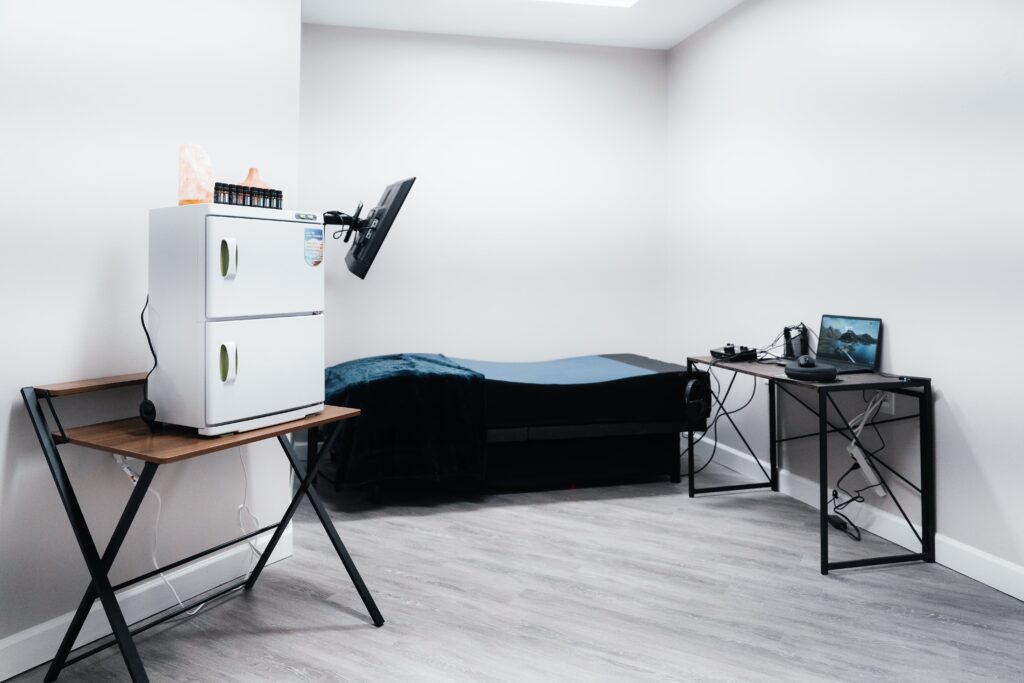Rapid cycling bipolar disorder represents one of the most challenging forms of this mental health condition, characterized by frequent and dramatic mood swings that can occur within days, weeks, or even hours.
Understanding rapid cycling is crucial for those affected and their loved ones, as it requires specialized treatment approaches and heightened awareness of symptoms.
If you or someone you care about experiences frequent mood episodes that seem to come and go without warning, you may be dealing with rapid cycling bipolar disorder.
At Arbor Wellness, our Bipolar Disorder treatment center in Nashville can help. Call us now at 629-217-2658 or verify your insurance.
What is Rapid Cycling?
Rapid cycling is a specific pattern of bipolar disorder where an individual experiences four or more distinct mood episodes within a 12-month period.
These episodes can include:
- Manic episodes
- Hypomanic episodes
- Depressive episodes
- Mixed episodes
Unlike typical bipolar disorder patterns where mood episodes may last weeks or months with periods of stability in between, rapid cycling creates a more chaotic and unpredictable pattern. The transitions between mood states can be abrupt, leaving individuals feeling as though they have little control over their emotional state.
It’s important to note that rapid cycling is not a separate diagnosis but rather a specifier used to describe the course of bipolar I or bipolar II disorder. Mental health professionals use this designation to better understand the severity and treatment needs of the individual’s condition.
The term “rapid” can be somewhat misleading, as it doesn’t necessarily mean mood changes occur rapidly within a single day.
Instead, it refers to the frequency of complete mood episodes over the course of a year. However, some individuals may experience even faster cycling patterns, sometimes called ultra-rapid or ultradian cycling, where mood changes occur within days or even hours.
Signs and Symptoms of Rapid Cycling
The signs and symptoms of rapid cycling bipolar disorder encompass all the typical symptoms of bipolar disorder but occur with much greater frequency and intensity.
Manic Episodes of Rapid Cycling
During manic or hypomanic episodes, individuals may experience:
- Elevated mood
- Increased energy
- Decreased need for sleep
- Racing thoughts
- Impulsivity
- Risky behavior.
These periods of elevated mood can feel euphoric initially but often become overwhelming and difficult to manage.
Depressive Episodes in Rapid Cycling
Depressive episodes in rapid cycling patterns include:
- Profound sadness
- Hopelessness
- Fatigue
- Changes in appetite and sleep patterns
- Difficulty concentrating
- Thoughts of self-harm or suicide.
The contrast between these low periods and the preceding high periods can be particularly jarring and disorienting.
Mixed Episodes
Mixed episodes, which can be especially common in rapid cycling patterns, present a particularly challenging combination of manic and depressive symptoms occurring simultaneously. Individuals might feel energized yet hopeless, or experience racing thoughts alongside deep sadness.
These mixed states can be particularly dangerous as they combine the impulsivity of mania with the despair of depression.
The rapid transitions between these states create additional symptoms unique to the rapid cycling pattern.
Many individuals report feeling exhausted from the constant emotional upheaval, confused about their identity and capabilities, and frustrated by their inability to predict or control their mood states.
Relationships often suffer as loved ones struggle to keep up with the dramatic shifts in personality and behavior.
Sleep patterns typically become severely disrupted, not just during mood episodes but also during transitions between states. Many people with rapid cycling report that sleep disorders and disturbances often serve as an early warning sign of an impending mood episode.
Causes & Risk Factors for Rapid Cycling
The development of rapid cycling bipolar disorder appears to result from a complex interplay of biological, psychological, and environmental factors. While the exact mechanisms aren’t fully understood, research has identified several key contributors to this challenging pattern.
Biological Factors
Biological factors play a significant role, with genetics being a primary consideration. Individuals with a family history of bipolar disorder, particularly rapid cycling patterns, face increased risk. Additionally, certain medical conditions affecting the thyroid, neurological disorders, and hormonal imbalances can trigger or exacerbate rapid cycling patterns.
Medication
Medication factors represent another crucial area of concern. Certain antidepressants, particularly when used without mood stabilizers, can trigger rapid cycling in susceptible individuals. Stimulant medications, corticosteroids, and even some over-the-counter supplements can contribute to mood instability and cycling patterns.
Substance Use
Substance use significantly increases the risk of developing rapid cycling patterns. Alcohol, recreational drugs, and even excessive caffeine can disrupt the delicate neurochemical balance necessary for mood stability. The relationship between substance use and rapid cycling often becomes cyclical, with individuals using substances to cope with mood episodes, which then triggers more frequent cycling.
Stress & Trauma
Stress and trauma, whether acute or chronic, can serve as powerful triggers for rapid cycling episodes. Major life changes, relationship difficulties, work stress, or traumatic experiences can destabilize mood and increase cycling frequency. The stress of living with bipolar disorder itself can sometimes contribute to the development of rapid cycling patterns.
Sleep Disruption
Sleep disruption, whether due to lifestyle factors, medical conditions, or other mental health issues, consistently emerges as both a trigger and consequence of rapid cycling. Irregular sleep schedules, sleep disorders, and chronic sleep deprivation can all contribute to mood instability.
Hormonal Changes
Hormonal changes, particularly those related to menstruation, pregnancy, menopause, or thyroid function, can significantly influence cycling patterns. Many women report changes in their bipolar symptoms related to their menstrual cycle, and some develop rapid cycling patterns during periods of hormonal transition.
How Often Does Someone Experience Rapid Cycling Bipolar Disorder?
Rapid cycling affects approximately 10-20% of individuals diagnosed with bipolar disorder, making it a significant but minority pattern within the broader bipolar spectrum.
Rapid cycling is more common in women than men, with some studies suggesting that women are two to three times more likely to experience rapid cycling. This gender difference may be related to hormonal factors, differences in treatment response, or varying patterns of help-seeking behavior.
The frequency can vary significantly among individuals and even within the same person over time. Some people may experience rapid cycling for a specific period and then return to more typical bipolar patterns, while others may continue with rapid cycling for extended periods.
Age also plays a role in rapid cycling frequency. While bipolar disorder often emerges in late adolescence or early adulthood, rapid cycling patterns may develop later, particularly in response to life stressors, medication changes, or the natural progression of the disorder.
How Long Does Rapid Cycling Last?
The duration of rapid cycling patterns varies considerably among individuals, ranging from months to years, and in some cases, becoming a chronic pattern that requires long-term management strategies.
For some individuals, rapid cycling represents a temporary phase in their bipolar disorder journey. These episodes might last several months to a few years before stabilizing into more predictable patterns. Often, these temporary rapid cycling periods coincide with specific life stressors, medication adjustments, or major life transitions.
Others experience rapid cycling as a more persistent pattern that requires ongoing specialized treatment approaches. In these cases, the focus shifts from eliminating rapid cycling entirely to managing and minimizing its impact on daily functioning and quality of life.
Several factors influence the duration of rapid cycling patterns.
- Consistent treatment adherence, including both medication compliance and therapy participation, significantly impacts cycling duration and intensity. Lifestyle factors such as regular sleep schedules, stress management, and avoiding substance use can help shorten rapid cycling periods.
- Early intervention and appropriate treatment modifications can also influence duration. Individuals who work closely with their treatment team to identify triggers and adjust treatment plans often experience shorter periods of rapid cycling and better overall outcomes.
Bipolar Disorder & Rapid Cycling Treatment Options
Treating rapid cycling bipolar disorder requires a comprehensive, individualized approach that often differs from standard bipolar disorder treatment protocols. The complexity and unpredictability of rapid cycling patterns demand specialized strategies and close monitoring by experienced mental health professionals.
Psychiatry & Medication Management
Psychiatry forms the cornerstone of rapid cycling treatment, but the approach must be carefully tailored. Mood stabilizers such as lithium, valproate, and lamotrigine are typically preferred over antidepressants, which can sometimes trigger or worsen rapid cycling. The medication regimen often requires more frequent adjustments and monitoring compared to typical bipolar treatment.
Psychotherapy
Psychotherapy plays a crucial role in rapid cycling treatment, with several evidence-based approaches showing effectiveness. Cognitive Behavioral Therapy (CBT) helps individuals identify triggers, develop coping strategies, and manage the cognitive distortions that often accompany mood episodes.
Lifestyle Modifications
Lifestyle modifications become even more critical in rapid cycling treatment. Establishing and maintaining regular sleep schedules, managing stress through relaxation techniques and mindfulness practices, and avoiding substances that can trigger mood episodes are essential components of comprehensive treatment.
Sleep Hygiene
Sleep hygiene receives particular attention in rapid cycling treatment, as sleep disruption both triggers and results from mood episodes. This may include specific sleep medications, light therapy, or referral to sleep specialists for comprehensive evaluation and treatment.
Regular monitoring and treatment adjustments are typically necessary, as rapid cycling patterns can change over time. This might involve more frequent appointments, mood tracking tools, and closer collaboration between different treatment providers.
Find Help for Bipolar Disorder Today
Living with rapid cycling bipolar disorder can feel overwhelming, but you don’t have to navigate this journey alone.
At Arbor Wellness, our experienced team understands the unique challenges of rapid cycling patterns and provides comprehensive, personalized treatment approaches designed to help you achieve greater stability and improved quality of life.
Our integrated treatment programs in Nashville combine evidence-based medication management, specialized therapy approaches, and lifestyle interventions tailored specifically for rapid cycling bipolar disorder.
Don’t let rapid cycling control your life any longer. Contact Arbor Wellness today to schedule a comprehensive evaluation and take the first step toward more predictable, manageable mood patterns. Our compassionate team is ready to help you develop the tools and strategies you need to thrive, not just survive, with bipolar disorder.
Call us now at 629-217-2658 or verify your insurance.

























